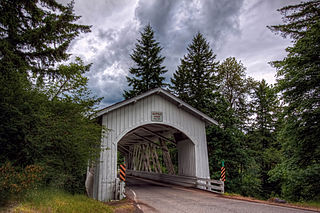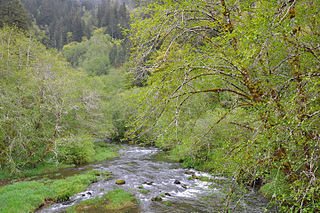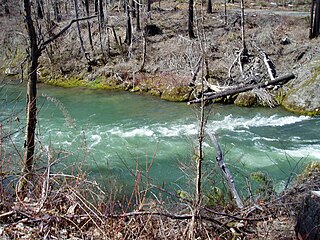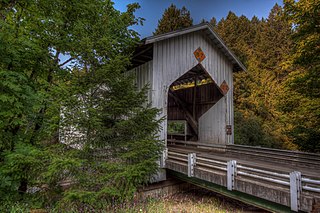| Ritner Creek | |
Ritner Creek Bridge interior in 2011 | |
| Name origin:For Sebastian Ritner, a settler whose donation land claim was along the creek [1] | |
| Country | United States |
|---|---|
| State | Oregon |
| County | Polk |
| Source | Central Oregon Coast Range |
| - location | near Bald Mountain |
| - elevation | 1,292 ft (394 m) [2] |
| - coordinates | 44°46′27″N123°32′29″W / 44.77417°N 123.54139°W |
| Mouth | Luckiamute River |
| - location | south of Pedee |
| - elevation | 279 ft (85 m) [3] |
| - coordinates | 44°43′43″N123°26′36″W / 44.72861°N 123.44333°W Coordinates: 44°43′43″N123°26′36″W / 44.72861°N 123.44333°W [3] |
Ritner Creek is a tributary of the Luckiamute River in Polk County in the U.S. state of Oregon. [4] The creek begins near Bald Mountain in the Central Oregon Coast Range and flows generally southeast to meet the Luckiamute southwest of Pedee and north of Kings Valley. The confluence is 31 miles (50 km) upstream of the Luckiamute's mouth on the Willamette River. [4] Named tributaries of Ritner Creek from source to mouth are Sheythe, Love, Clayton, and Kinsey creeks. [4]

The Luckiamute River is a tributary of the Willamette River, about 61 miles (98 km) long, in western Oregon in the United States. It drains an area of Central Oregon Coast Range and the western Willamette Valley northwest of Corvallis.

Polk County is a county located in the U.S. state of Oregon. As of the 2010 census, the population was 75,403, making it the least populous county in the Willamette Valley. The county seat is Dallas. The county is named for James Knox Polk, the 11th president of the United States.

In the United States, a state is a constituent political entity, of which there are currently 50. Bound together in a political union, each state holds governmental jurisdiction over a separate and defined geographic territory and shares its sovereignty with the federal government. Due to this shared sovereignty, Americans are citizens both of the federal republic and of the state in which they reside. State citizenship and residency are flexible, and no government approval is required to move between states, except for persons restricted by certain types of court orders. Four states use the term commonwealth rather than state in their full official names.
Contents
Ritner Creek passes under Oregon Route 223 just before entering the river. The Ritner Creek Bridge, a 75-foot (23 m) covered bridge, carried the highway over the creek until 1976. Replaced by a concrete span, it was the last covered bridge on an Oregon state highway. [5]

Oregon Route 223 is a state highway in the U.S. State of Oregon, which runs between the town of Wren, Oregon and the city of Dallas, Oregon. It is known as the Kings Valley Highway No. 191 and is 31 miles (50 km) long. It lies in Benton and Polk counties.

The Ritner Creek Bridge was the last covered bridge on a state highway in Oregon. It carried Oregon Route 223 (OR 223) over Ritner Creek between Pedee and Kings Valley, about 15 miles (24 km) south of Dallas, or 10 miles (16 km) north of the junction with U.S. Route 20 (US 20) in Wren. Built in 1927, in 1976 the bridge was lifted from its foundation and relocated just downstream of its original site and replaced by a concrete bridge. The bridge was constructed in 1927 by Hamer and Curry Contractors to Oregon State Highway Commission plans. The initial construction cost was $6,964. The original portal design was rounded at the edges but was changed to a square design in the early 1960s to accommodate larger loads to pass.

A covered bridge is a timber-truss bridge with a roof, decking, and siding which, in most covered bridges, create an almost complete enclosure. The purpose of the covering is to protect the wooden structural members from the weather. Uncovered wooden bridges typically have a lifespan of only 20 years because of the effects of rain and sun, but a covered bridge could last 100 years.



















